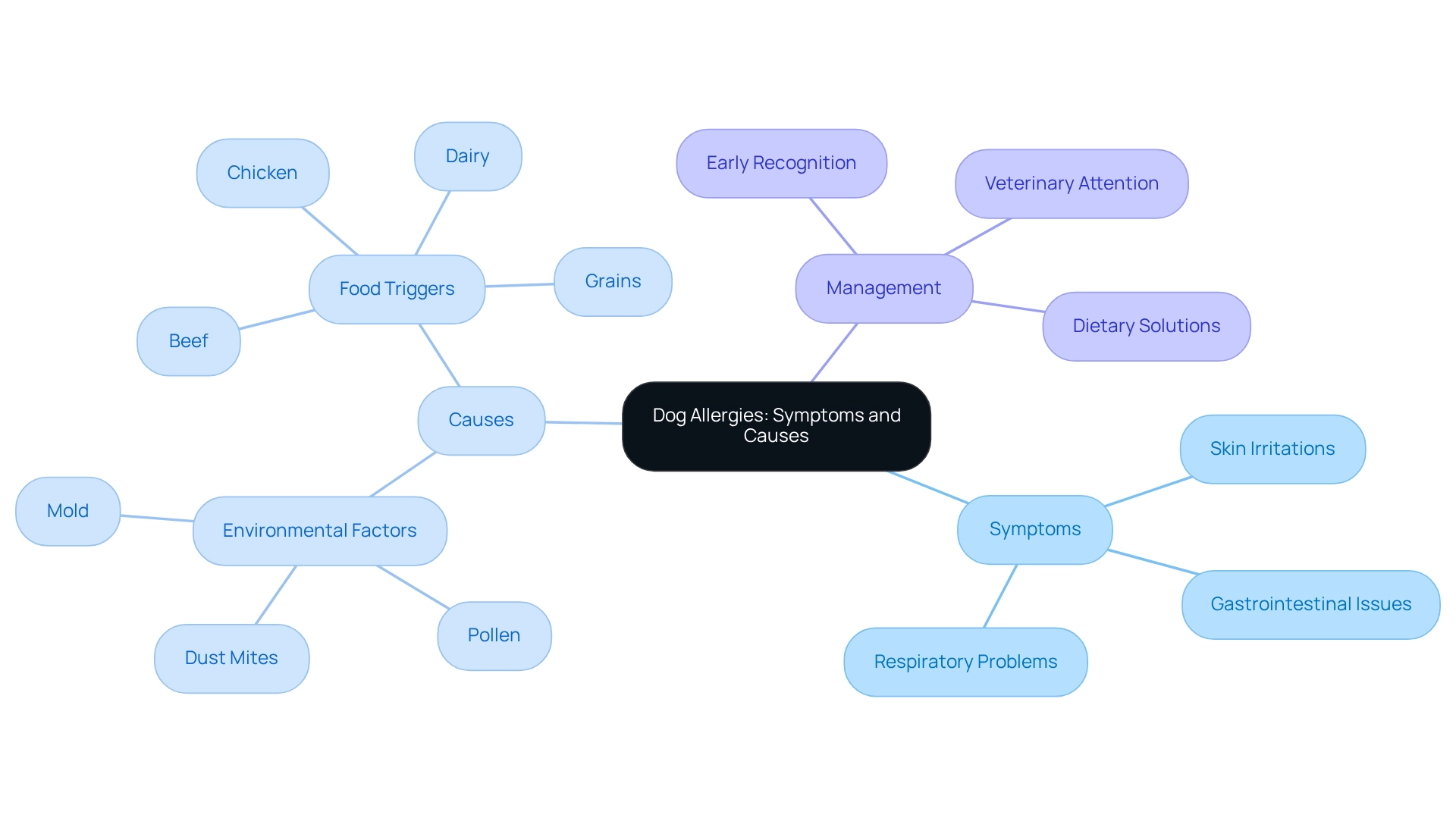Best Dog Food for Allergies: Compare Top Brands for Your Pet
Overview
This article highlights the journey of finding the best dog food for allergies, focusing on top brands that cater to our beloved pets with dietary sensitivities. Understanding your concerns about your furry family members, it outlines key criteria for selecting allergy-friendly dog food, such as:
- Limited ingredients
- Novel proteins
Through a compassionate lens, we compare trusted brands like:
- Purina Pro Plan
- Hill’s Prescription Diet
showcasing their effectiveness in managing allergic reactions in dogs. We recognize the importance of nurturing your pet’s health and well-being, and we invite you to explore these options to ensure your dog’s happiness and comfort.
Introduction
In the realm of pet care, dog allergies have become a significant concern, impacting countless furry family members and their devoted owners. These allergies can manifest in various forms, from persistent skin irritations to distressing gastrointestinal issues, prompting pet owners to seek effective solutions. Recognizing the symptoms and triggers of these allergies is crucial for ensuring the health and happiness of our beloved dogs.
As environmental factors and dietary ingredients increasingly contribute to allergic reactions, making informed choices has never been more vital. This article explores the complexities of dog allergies, providing insights into their causes, criteria for selecting allergy-friendly dog food, and a comparative analysis of leading brands designed for sensitive pups. By empowering pet owners with knowledge, we can embark on a journey towards a healthier and more comfortable life for our cherished companions.
Understanding Dog Allergies: Symptoms and Causes
Understanding dog sensitivities is essential for every pet owner, as they can manifest in various ways, including skin irritations, gastrointestinal issues, and respiratory problems. You may notice your furry family members experiencing excessive scratching, licking, ear infections, or gastrointestinal upset. Allergies in dogs can be triggered by environmental factors like pollen, dust mites, and mold, along with food components such as beef, chicken, dairy, and grains. As we move into 2025, it is increasingly important for pet owners to recognize that these sensitivities are becoming more prevalent, requiring awareness of potential irritants and nutritional solutions.
Veterinarians stress the significance of early recognition of these symptoms to prevent further complications. For example, a case study on sensitivities and climate change indicates that worsening pollen seasons are increasing allergen exposure, potentially intensifying symptoms in sensitive dogs. This underscores the need for public health initiatives aimed at addressing the effects of environmental changes on the prevalence of sensitivities.
Moreover, it is crucial for pet owners to understand that severe allergic reactions necessitate immediate veterinary attention. By comprehending these symptoms and their origins, you can better identify potential allergens and explore the best dog food for allergies as a dietary solution for your companions. By being proactive and informed, you can effectively manage your dogs’ allergies by selecting the best dog food for allergies, ensuring a healthier and happier life for your furry friends. Remember, your commitment to understanding their needs creates a nurturing environment where they can thrive.

Criteria for Choosing Allergy-Friendly Dog Food
When selecting allergy-friendly dog food, it’s important for pet owners to consider several key criteria to ensure your furry family members receive the best nutrition while minimizing allergic reactions:
- Limited Ingredients: Choosing foods with fewer ingredients is a smart way to reduce the risk of allergic reactions. Look for brands that clearly specify the source of protein and avoid common allergens like chicken, eggs, and dairy. Remember, common allergens for canines include chicken, eggs, beef, dairy, soy, and wheat gluten, making wise choices essential.
- Novel Proteins: Ingredients such as kangaroo, venison, or fish can be particularly beneficial for pets with sensitivities to more typical proteins. These novel proteins may help alleviate hypersensitivity symptoms and are found in the best dog food for allergies, providing essential nutrients.
- Grain-Free Choices: Many canines show sensitivities to grains, making grain-free formulations some of the best dog food for allergies to help ease symptoms linked to dietary intolerances.
- Hydrolyzed Proteins: These proteins are broken down into smaller components, making them less likely to trigger an allergic response. This can be especially beneficial for canines with intense sensitivities.
- Quality Assurance: It’s crucial to choose brands that provide the best dog food for allergies and adhere to strict manufacturing standards to prevent cross-contamination with allergens. This ensures that the food is safe and appropriate for canines with specific dietary needs.
As noted by Craig Datz, DVM, MS, additives like preservatives, flavors, and dyes can often be involved in sensitivities, though they have not been documented to be linked with sensitivities in canines. By focusing on these standards, you can make informed choices that enhance your pets’ health and well-being, particularly for those dealing with sensitivities or skin issues. Moreover, around 30% to 50% of animals with skin indications of dietary sensitivity also display gastrointestinal symptoms like vomiting and diarrhea, highlighting the importance of selecting suitable diets for your beloved companions.
Comparative Analysis of Top Dog Food Brands for Allergies
Here is a caring comparative analysis of some of the top dog food brands for allergies, aimed at helping you make the best choice for your furry family members:
-
Purina Pro Plan: Hydrolyzed protein diet, highly digestible
- Pros: Vet-recommended, effective for many dogs
- Cons: Higher price point ($53)
-
Hill’s Prescription Diet: Formulated for food sensitivities, contains novel proteins
- Pros: Clinically proven, good palatability
- Cons: Requires vet prescription
-
Royal Canin: Tailored formulas for specific allergies, hydrolyzed options available
- Pros: Wide range of options, trusted brand
- Cons: Some formulas may contain grains
-
Blue Buffalo Basics: Limited ingredient diet, no chicken or beef
- Pros: Affordable, good for sensitive stomachs
- Cons: May not be suitable for all allergies
-
KOHA Limited Ingredient: Focus on novel proteins, grain-free options available
- Pros: High-quality ingredients, good reviews
- Cons: Limited availability in some regions
This analysis highlights the unique aspects of each brand, allowing you, as a caring pet owner, to weigh your options based on your dog’s specific needs. Significantly, Purina Pro Plan is emphasized for its efficacy in handling sensitivities, backed by veterinary endorsements. As Dr. Michelle Burch, a veterinarian and veterinary consultant, states, “I do not recommend using blood, hair, or saliva tests for allergies,” emphasizing the importance of proper diagnosis. Additionally, understanding common allergens—such as chicken, beef, dairy, soy, and wheat gluten—underscores the necessity for tailored diets, as highlighted in the case study titled “Common Allergens in Dog Food.” This understanding helps keep your dogs safe and comfortable, ensuring that you can select the best food for your beloved companions.
Conclusion
Recognizing and addressing dog allergies is essential for maintaining the health and happiness of your furry family members. Allergies can manifest in various forms, such as skin irritations and gastrointestinal issues, often triggered by environmental factors and specific food ingredients. By identifying symptoms early and understanding potential allergens, you can take proactive steps to ensure your dog’s well-being.
When selecting allergy-friendly dog food, several important criteria come into play:
- Choosing limited ingredient diets
- Opting for novel proteins
- Selecting grain-free options
- Choosing high-quality brands that adhere to strict manufacturing standards to avoid cross-contamination
A comparative analysis of leading dog food brands provides valuable insights, empowering you to make informed decisions tailored to your pet’s specific needs.
Ultimately, the journey toward managing dog allergies involves a blend of awareness, education, and thoughtful dietary choices. By prioritizing the health of your beloved companions and making informed decisions, you can create a more comfortable and fulfilling life for your dogs, free from the burdens of allergies. Together, let’s nurture a happier, healthier environment for your cherished pets.
Frequently Asked Questions
What are the common symptoms of dog allergies?
Common symptoms of dog allergies include excessive scratching, licking, ear infections, skin irritations, gastrointestinal upset, and respiratory problems.
What can trigger allergies in dogs?
Allergies in dogs can be triggered by environmental factors such as pollen, dust mites, and mold, as well as food components like beef, chicken, dairy, and grains.
Why is it important for pet owners to recognize allergy symptoms early?
Early recognition of allergy symptoms is crucial to prevent further complications and to manage the dog’s health effectively.
How is climate change affecting dog allergies?
Climate change is worsening pollen seasons, which increases allergen exposure and potentially intensifies allergy symptoms in sensitive dogs.
What should pet owners do in case of severe allergic reactions?
Severe allergic reactions in dogs necessitate immediate veterinary attention to ensure the health and safety of the pet.
How can pet owners manage their dogs’ allergies through diet?
Pet owners can manage their dogs’ allergies by selecting the best dog food for allergies, which can help alleviate symptoms and improve their overall health.
Why is it essential to be proactive in understanding dog allergies?
Being proactive and informed about dog allergies allows pet owners to better identify potential allergens and create a nurturing environment for their pets to thrive.







